|
Take home message: even
at the current exchange rates, eating out in Tuscany can be
significantly cheaper than back home. Read on.
Breakfast: a great many
Italians, especially those heading off to work, stop either at
their local bar or at their favorite bar near work for a cappuccino
and a pastry. Note that coffee and a pastry will cost a lot less standing
at the bar than sitting down at a table. That's breakfast. For
tourists, some hotels offer a cooked breakfast but by far the
majority offer a buffet of some kind. Many also provide bread
because that's what tourists ask for, but Tuscan bread,
whether it's toasted or not, is not meant for butter and jam.
We recommend when in doubt, to do what the natives do. A
coffee currently costs about 1.25 standing at a bar the
clientele of which are mostly local (And as much as 7.00
if you sit down outside a bar located in front of a major
tourist attraction - unless people watching is your
hobby, take your coffee standing at the bar.). Note that if
you will take a coffee and/or a pastry standing at the bar, you
should pay at the cash register BEFORE
going with your receipt to the pastry counter and then the
coffee counter. A chocolate-filled
croissant costs 1.00. The days of chasing it down with a
glass of grappa are more or less gone! Read
here about coffee in Italy.
A brief note on cover charges, service charges and
tips in Italy
Cover charge (Pane e coperto)
- this is a fixed charge
per head which shouldn't be more than
1.50 or possibly 2.00 per person. It pays for
the bread and "table cloth" (table
setting). It's a fair charge because it's a fixed
amount so that those who take a snack and those who
eat a full dinner pay the same. Essentially, setting
and cleaning the table costs the same for both. This
is a legal charge in Tuscany but apparently not in
Lazio (Rome), for example.
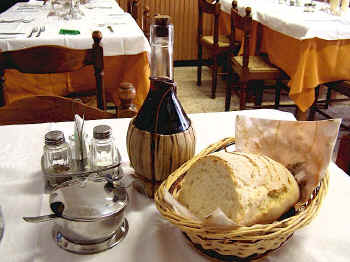
Pane ed
olio - bread and olive oil - your cover charge pays
for this.
Service charge (Servizio) - this is a percentage
and is effectively a mandatory tip. Factor
that into your decision on whether the prices suit
you or not. It's usually 10% or 12.5%. Top tourist
locations sometimes charge as much as 20%. Local
eateries usually charge no servizio at all.
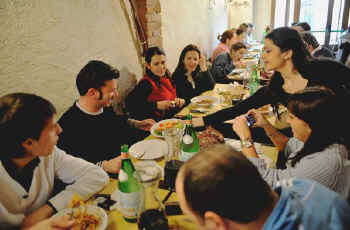
Servizio
- usually added to the bill
Tipping - it is NOT
the custom to leave a tip in Italy, whether a servizio
was added to your bill or not. Waiters are
paid proper wages, get holiday pay, health care,
pension etc. They do not depend on tips to live or
to do their job properly. In small places, most of
the staff are members of the owner's family. If you
wish, you can round up your bill by a euro or two if
the waiter takes the payment. Obviously, if you take
your bill to the cash register and pay, there's no
rounding up.
Water comes by the bottle, still (naturale)
or sparkling (frizzante), and you pay for
this. If you don't want it, don't order it. In
theory you can ask for tap water (acqua dal rubinetto)
but since a 1.5 liter bottle of mineral water costs 1.50 or
2.00 and tastes a lot better, there's not much
point. |
|
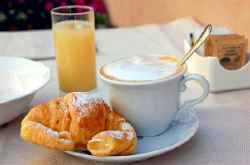
Tuscan breakfast
|
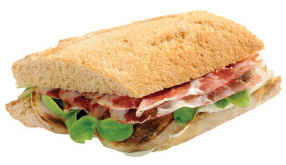
Lunch - a prosciutto panino
|
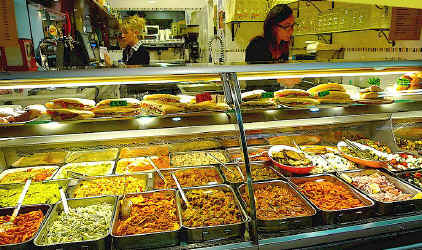
A paninoteca
|
If you're planning to stay in the Tuscan countryside, there
are a great many Bed
and Breakfast accommodations offering an equally great
range of breakfasts. Be sure to ask if you have special
wishes, but in general a country B&B will do a good,
Italian-style breakfast unless instructed otherwise. If you're
staying in a hotel and don't plan to eat breakfast there, you
might be able to get a cheaper rate by specifying that when
you check in.
Lunch: Italians eat lunch
starting at 1pm and most restaurants are not ready to serve a
sit-down lunch before that time. A restaurant lunch is usually
a major meal, especially on Saturdays and holidays. The more
common alternative is a sandwich (panino), made fresh
according to your instructions in a paninoteca. A
really good roast pork sandwich (with fresh tomatoes, salad of
some kind, green sauce) should cost 2.50 to 4. A wide range
of cold cuts, cheeses (mostly
pecorino), fruit and, for those who have rented an
apartment, ready-to-go cooked food is readily available in
supermarkets and innumerable small food outlets. Note that
these latter sometimes close from about 1 pm to 4 pm so buy your lunch
materials before 1 pm.
Dinner: This is usually
the main meal of the day and at home starts at 8.00 pm on the
dot. Again, most restaurants will not be ready to serve dinner
until 7.30 pm at the earliest. A full scale dinner consists of
a plate of appetisers (antipasti such as crostini
and/or salumi), a pasta course and then a main course (secondo).
The constituents of the main course are usually ordered
separately, meaning that you will choose the kind of meat or
fish dish you want and then the accompaniments (contorni)
such as sliced tomatoes, fried potatoes, beans, artichokes
etc. Of course, all of these arrive on separate plates so you
can order a selection suitable for sharing among your whole
group. Similarly, if you order a Florentine
steak (bistecca alla fiorentina), you should
select a size to match the number of people who will share it.
The steak will arrive on its own plate already cut into
strips. Steak and also sometimes fish are priced per
etto (per 100 grams) not per serving. You then finish up with a dessert and a coffee (never a cappuccino
after dinner) and maybe a vin santo or a grappa.
You order water and wine to go with the entire meal. Note that
the open house wine, ordered by the half or full litre
carafe will usually be very good and very inexpensive.
|
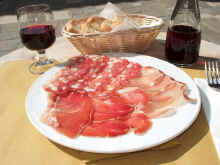
Antipasta - salumi |
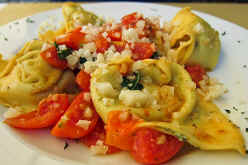
Primo piatto - ravioli |
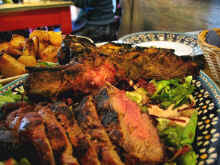
Secondo piatto - bistecca |
You do not have to order all courses. A great many people are
satisfied with an antipasto and a pasta course plus a coffee, or
some other lesser combination. A group of four can order an
antipasto for two as part of their meal - this is common
practice. A cover charge will be added to
the bill (this is a fixed sum that pays for the bread and table
setting) and nowadays the service charge is also often added.
Tipping is therefore neither required nor expected. Often you
can pick up your bill, take it to the cashier and pay there.
What will a restaurant meal
cost in Tuscany?
The variables for "normal" restaurants (meaning
those without
gourmet pretentions) are as follows:
Mostly local clientele or mostly tourists - usually a place
packed with locals will be a better deal in terms of both
price and taste. There are still
fixed price offers in densely touristed zones where you
know exactly what courses you are getting. However, quality and to a lesser extent quantity will be a matter of chance.
Fixed price places are generally to be avoided for dinner
unless price is the overwhelming factor. Restaurants
recommended by guide books should be double checked on web
sites for current customer reviews. In not a few cases, some
of these recommendations are living on their past glory.
Grand piazza or back street -
obviously, a plush restaurant opening onto the main avenue
or a famous piazza is likely to have high prices, while a trattoria
a block or two away or out in the suburbs will offer a much
better deal for essentially the same or better food.
Tourist city or country town - costs and the
market allow higher prices in the centres of art cities like
Florence and even in some smaller but touristy places such
as Montalcino and San Gimignano. Restaurants in less frequented country
towns and especially villages usually offer very good value
for money.
Town or country - the Tuscan countryside is
dotted with rural restaurants which are almost without
exception excellent places to eat for the simple reason that
they rely heavily on a local clientele. If you have the
choice, a Tuscan country restaurant is the place to eat
dinner. (Yet another reason to stay in the country and go
into the cities by day just for the art and architecture.)
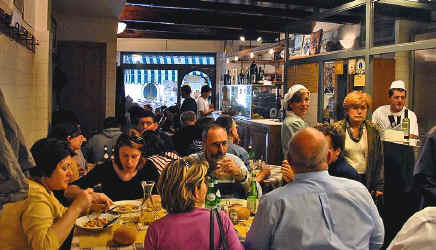
Trattoria
in Florence
Here we reproduce, partly translated, two menus from
village restaurants in the Chianti Classico area between
Florence and Sienna. The food served at these restaurants is
excellent, they both have outside terraces and the prices are
representative of village and country restaurants. (Note that
truffles - tartufi - and hence truffle dishes are
expensive.) In other
words, prices within the variables listed above will be similar
to one another, while the cookery and service varies. Ask local
people for tips on the best places in the area.
Antipasti |
Primi piatti |
Secondi piatti |
Contorni |
Selection of salumi
11.00
Large plate of cheese with jam 12.00
Plate of pecorino with honey 8.00
Pickled artichokes 8.00
Tomino cheese with fresh truffles 10.00
Creamy mozzarella with fresh truffles 10.00
Tuscan chicken liver crostini 5.00
Tomato bruschetta 5.00
Prosciutto and melon 9.00
Marinated lard 7.00 |
Taglierini with fresh truffles 15.00
Pappardelle with wild boar sauce 9.50
Fresh pasta
Ravioli filled with fresh truffle and mushrooms
16.50
Ravioli filled with ricotta and lemon, with gorgonzola
sauce and walnuts 10.00
Short pasta with truffle sauce and sausage 10.00
Gnocchi and tomato sauce 9.00 |
Wild boar stew
13.00
Stewed beef with black peppers 11.00
Scrambled eggs with fresh truffles 12.00
Bocconcini di pollo 13.00
Charcoal
grilled
Sliced beef with
fresh truffles 22.00
Sliced beef with balsamic vinegar 18.00
Sliced beef with rosemary and green peppers 18.00
Sliced beef with lard 18.00
Florentine beefsteak 4.50 per etto |
Fagioli cannellini
(white beans) 5.00
Grilled vegetables 5.00
Mixed or green salad 5.00
Large salad 8.00
Dolce (Desserts)
All desserts cost 5.00
Cover charge 2.00 |
Antipasti |
Primi piatti |
Secondi piatti |
Contorni |
Toast with olives, garlic and
Tuscan olive oil
5.00
Tomato bruschetta 5.00
Toast with lard 5.00
Wild boar salamino 6.00
Tuscan bacon with fennel seeds 5.00
Tuscan salami with fennel seeds 8.00
Selection of salumi 8.00
Mixed crostini 5.00
Prosciutto with melon 10.00
A big selection of pecorino cheese, ham, salami, crostini
for 2 persons 20.00
Tuscan ham, salami and crostini 10.00
Mozzarella and tomatoes 7.00
A selection of vegetables preserved in olive oil 5.00 |
Spaghetti
with beef sauce 8.50
Spaghetti with wild boar sauce 11.00
Spaghetti alla pomarola 7.00
Ribollita (bread, bean, carrot and chard soup) 8.50
Panzanella (Tuscan bread salad with cucumber, onion,
tomato and basil) 6.50
Salad with tuna, beans, tomato and onions 8.00 |
Charcoal
grilled
Veal steak 4.00
per etto. (The average size is 3-4 etti.)
Pork steak 10.00
Pork ribs 10.00
Pork sausages 9.00
Florentine beefsteak (genuine Chianina) 4.30 per etto
(For 2 persons, average size
8.5-11.5 etti.) |
Seasonal
vegetables 5.00
Fagioli cannellini (white beans) 5.00
Mixed salad 5.00
Dolce (Desserts)
Almond biscuits with
vinsanto 5.00
Cake 5.00
Pecorino cheese with honey and vinsanto 6.00
Pecorino cheese with pears, fig jam and nuts 6.00
Fresh fruit 4.00
Caffθ Moka 1.50 |
Restaurants
near Greve in Chianti
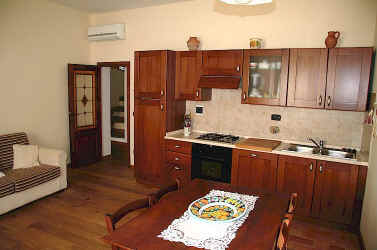
Last but not least, don't forget that you can
stay in a self-catering vacation apartment or farmhouse for much
less than the price of staying in a hotel. Even if you don't
want to cook, you can buy ready prepared hot and cold
eats at any supermarket and at innumerable speciality
food shops. All supermarkets offer a great selection
of local wines at excellent prices.
A
selection of vacation accommodation in Chianti. |
|